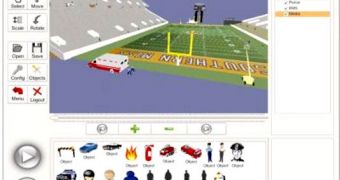The US Department of Homeland Security (DHS) and the Federal Bureau of Investigations (FBI) are all-too-aware of the mayhem and devastation a prospective terrorist attack on a crowded sports stadium could cause. Authorities have been aware of the risks entailed by such a scenario, but thus far solutions have proven impossible to find. It's hard enough getting all those people inside the stadium, in a process that takes hours, but how do you evacuate in excess of 70,000 people in less than an hour? This is the question a new simulation software is trying to answer.
The new breed of simulation software is being developed and preliminary tested at the National Center for Spectator Sports Safety & Security (NCS4), which is located at the University of Southern Mississippi (USM). The development of the SportEvac simulator is being supported with grant money obtained from the DHS Science and Technology Directorate (S&T). The entire research effort is an integrated part of the Southeast Region Research Initiative (SERRI), and it is aimed at developing viable ways of saving as many lives as possible in case of a terrorist attack on a crowded stadium.
In a scenario where, for example, emergency lights fail after an explosion, a column of people, most likely up to 50-person wide and several thousand long would form. In the dark, a giant stampede would ensure, as every single person in the crowd would flee for his or her own life. There is also the fear factor. Even if individuals could exit the arena in an orderly fashion fairly quick, and with a great deal of efficiency, they are very likely not to do so, on account of the panic that an explosion instills. To make matters even worse, there is no way for authorities to simulate these scenarios other than on computers. Finding 70,000 people willing to trample themselves for science is not an easy task.
“SportEvac isn't simply more realistic. It will become a national standard,” S&T Infrastructure and Geophysical Division program manager Mike Matthews explains. The program can account for a wide variety of things that other simulations simply failed to consider, such as for example the behavior of a single fan, which may return after a forgotten possession, a fixed bench that would hinder the evacuation flow, a fan's car parked in an erroneous position, and so on. The simulation would basically create a stadium filled with 70,000 avatars, each capable of behaving differently, and also unpredictably.

 14 DAY TRIAL //
14 DAY TRIAL //